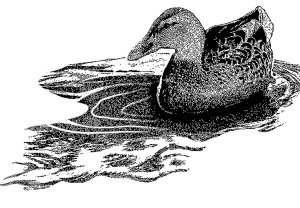BARA Bugle (Broadmead Area Residents Association Newsletter), Fall 2007 – John Lucas
A couple of Bugles ago, I wrote of my older brother Eugene’s fascination with birds and flight and his wise words to me about red-winged blackbirds. That was just the first of many talks that turned me into an avid birdwatcher.
Eugene once described mallard ducks as “the Christopher Columbus of birds”, which I found puzzling and funny. He explained that the first mallards must have been as great explorers as anyone who sailed on the Santa Maria because they were to be found everywhere. They went to all corners of the earth, discovered great places to live, took over, and established themselves just like our colonists. He said they were also commonly known as wild ducks, but he preferred to think of them as free – free to go anywhere they wanted. And they did. And so they became the progenitors of all domestic ducks, except the Muscovy, a particularly stubborn duck who, according to Eugene, refused to cooperate and interbreed.
Everything Eugene said to my eight-year-old self was true. The mallard is the most recognizable of all ducks, the male possessing a gorgeous iridescent green head, a black-tipped yellow bill, a black derriere, and a wide, graceful wingspan of about eighty to ninety centimetres. He is typically sixty centimetres long and weighs in at about one kilo. While the female is less resplendent, she is, nevertheless, a very pretty creature: light brown in colour and somewhat smaller than the male. Both sexes have a beautiful blue speculum (a bright iridescent patch of colour on the wings) visible in flight. In non-breeding times, the male becomes drab to some degree. Eugene used to laugh and say that this distinguished him from his human counterparts who are always on the prowl and dress accordingly.
Wetlands are the favourite haunts of mallards. Fortunately for us, Broadmead is full of wetlands, such as Pondwood, the development with the lovely artificial lake just off Royal Oak Drive, and the deeper ditches surrounded by plant and tree life, as on the Rolston Trail. But Rithet’s Bog, with its larger stretches of open water, is the principal one to observe the mallard in its habitat. The perimeter trails allow the walker to come quite close to the flocks of ducks and to pairs with growing ducklings.
And speaking of flocks and pairs, these birds are very gregarious but do split off into pairs during the mating season. The male stays with the female until the eggs, often as many as a dozen, are hatched. Eugene once took me to see very young ducklings to show me how amazing they are: as soon as they are born they can swim and eat on their own. Only years later did he inform me that the term for this ability in the animal kingdom is precocial. During this early part of their lives the ducklings stay close to their mother who ensures they are well-tended and water-proofed (they are not born that way).
Mallards are dabbling ducks, which means that they do not dive underwater for their food but eat at or near the surface of the water. For the walkers and birdwatchers of Broadmead, this is a real gift because we can at their various habitations observe them going about their business at close range, and even feed them various grains that they happily include in their diet. Please, however, no bread! They are one of our natural treasures and we must keep them healthy.
(This is the second in a series of articles on Broadmead Birds written by John Lucas. For more information on the mallard check the sites of Ducks unlimited, one of the benefactors of Rithet’s Bog and its ambiance.)
